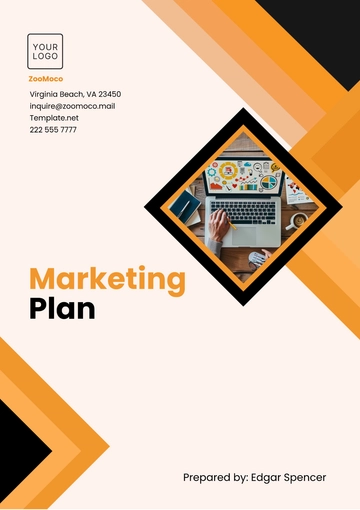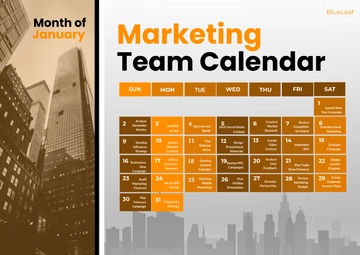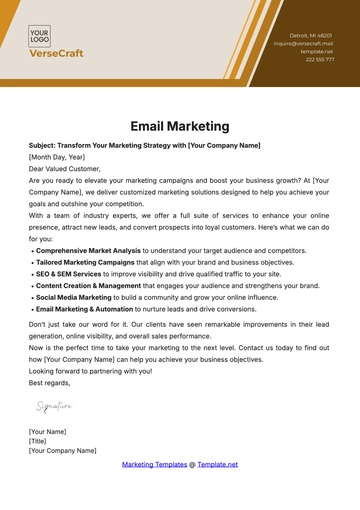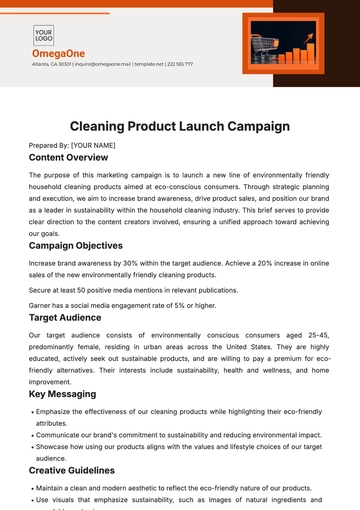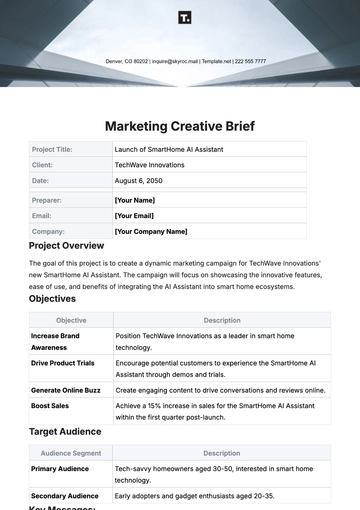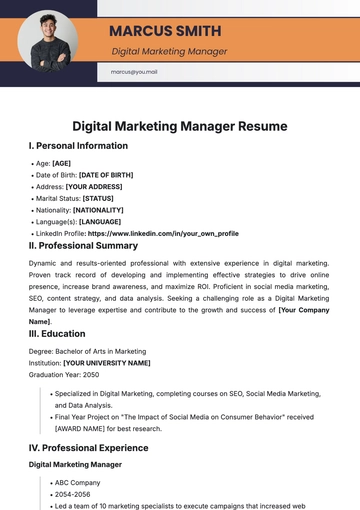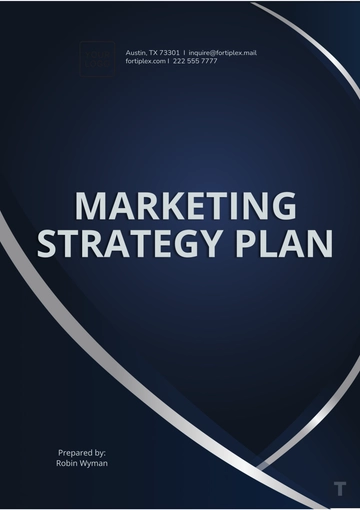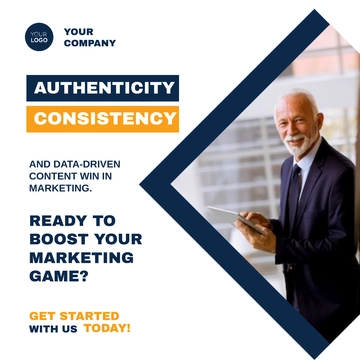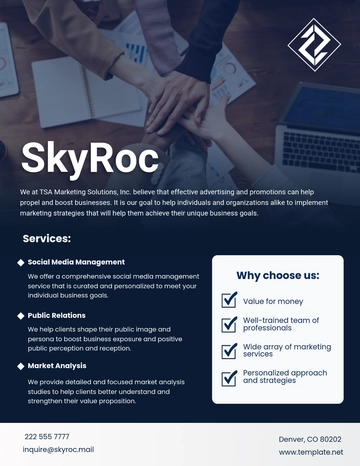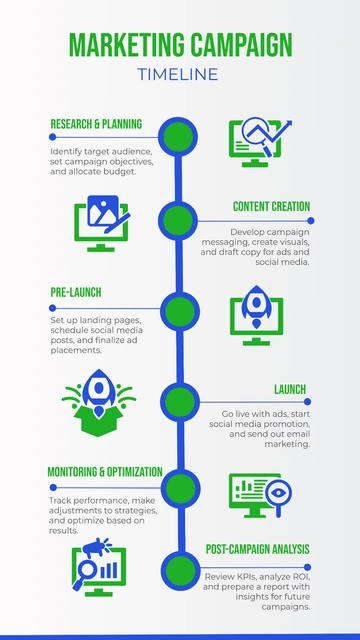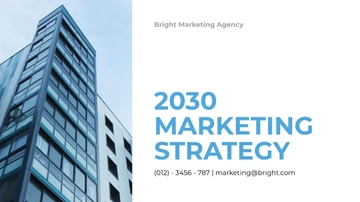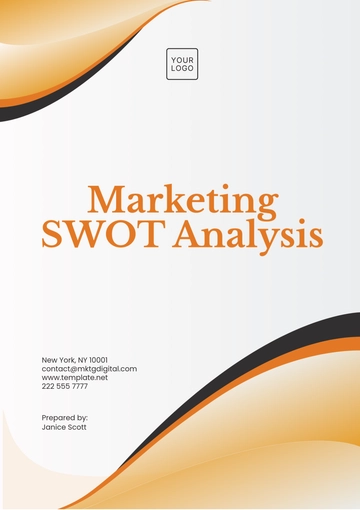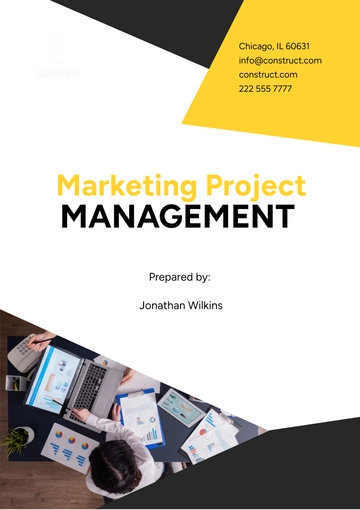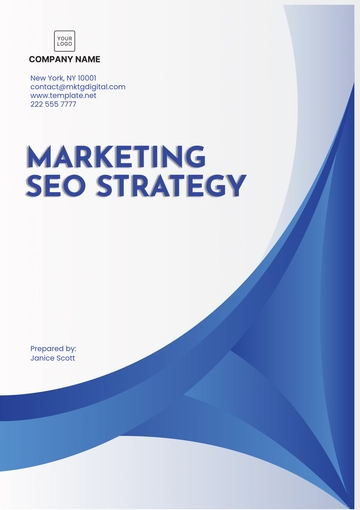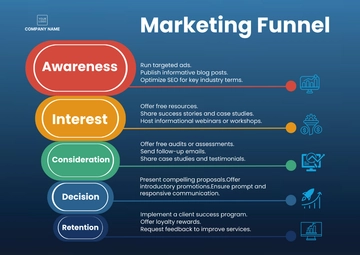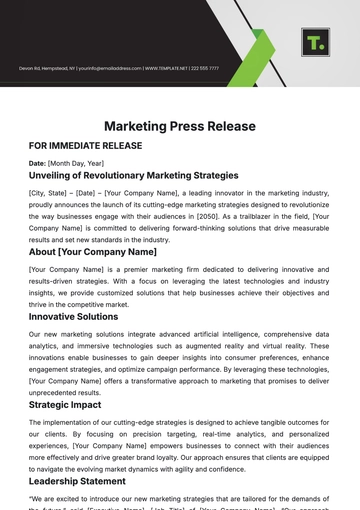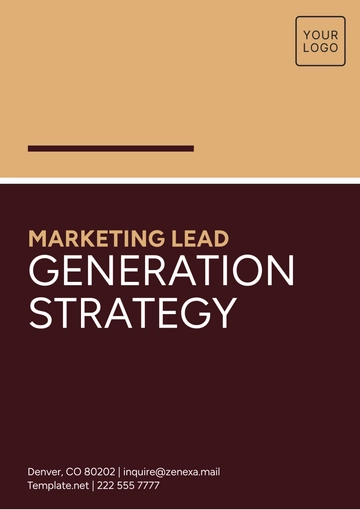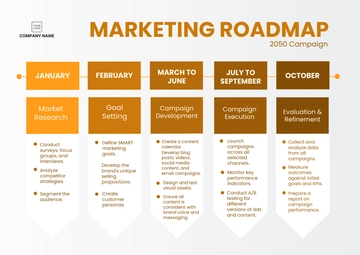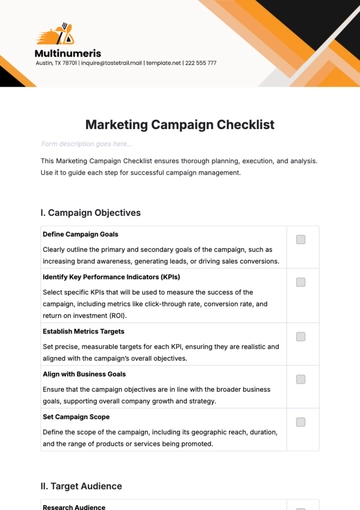Free Marketing Financial Management for Events and Trade Shows
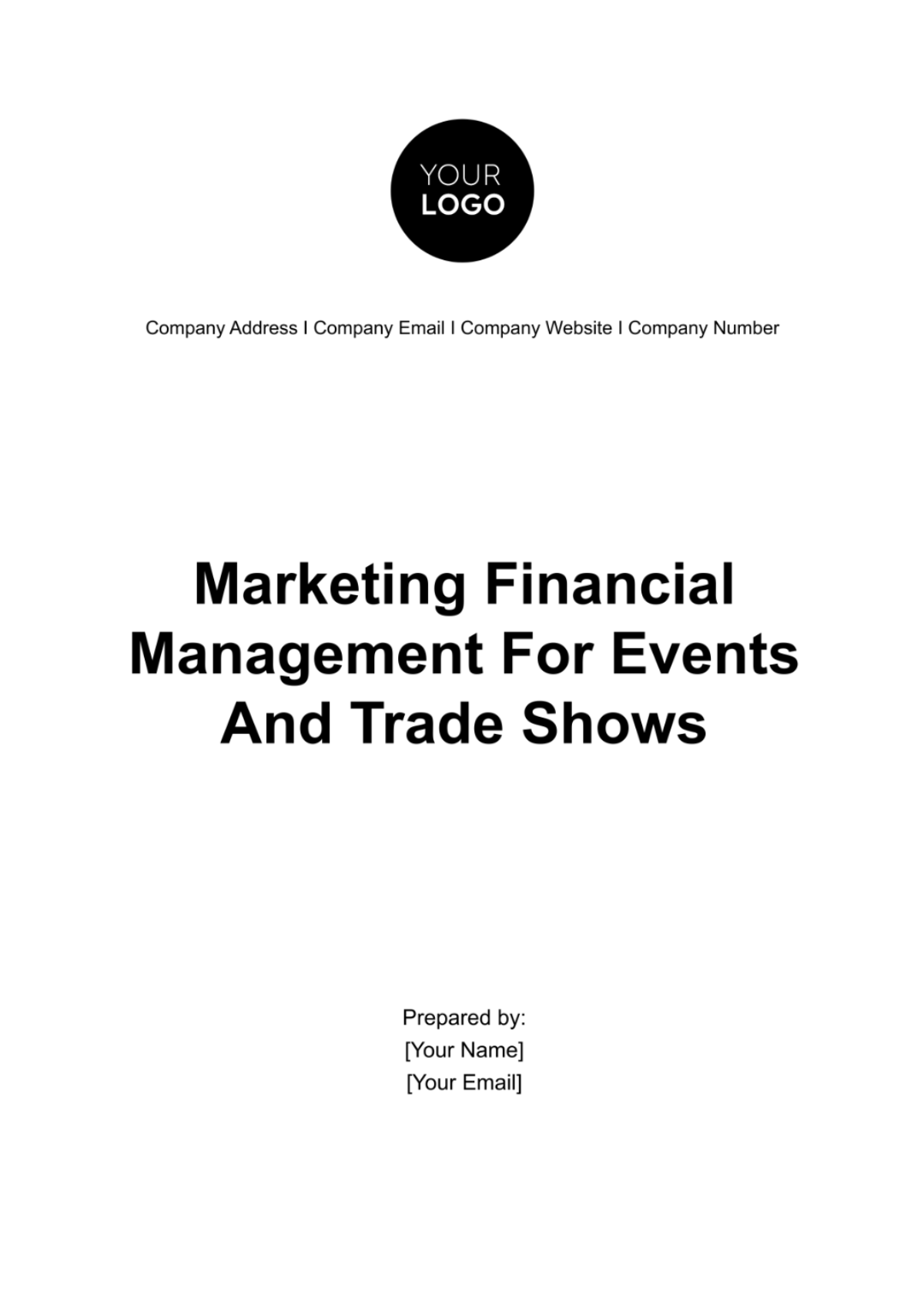
In the bustling city of [City], a dedicated team of event organizers was gearing up for the [Event / Trade Show Name], an annual extravaganza celebrating the latest advancements in technology and innovation. Among them was [Organizer’s Name], the [Position], tasked with ensuring that every dollar invested in marketing would yield a substantial return on investment (ROI).
I. Preparation And Budgeting
In the bustling heart of Innovateville, a dedicated team of event organizers gathered in a sleek, glass-walled conference room, their eyes fixed on the horizon. Among them, [Organizer’s Name], the [Position[] stood poised to transform [Event / Trade Show Name] into a celebrated showcase of innovation. With unwavering determination, she embarked on an arduous journey of meticulous preparation and strategic budgeting that would ultimately define the event's success.
[Organizer’s Name]initiated this journey months ahead of the scheduled event date, her keen eye discerning the need for meticulous planning to navigate the complexities of financial management. Her first step was to delve into the annals of the previous year's financials, dissecting each line item with an analytical precision that mirrored the tech innovations [Brand] celebrated. These insights provided a crucial map of successes and pitfalls, guiding her in crafting a budget as solid as the foundation of a skyscraper.
Budget Development And Allocations
In the dimly lit hours of late evenings, [Organizer’s Name] meticulously drafted a comprehensive marketing budget. Every line was meticulously considered, each allocation was justified with a well-reasoned strategy. This financial blueprint included provisions for various facets of the Expo's marketing efforts, each requiring its share of the budgetary pie:
Digital Dominance | Recognizing the predominantly digital presence of the tech-savvy audience, [Organizer’s Name] allocated a significant portion of the budget to digital marketing. The plan included targeted online advertising campaigns that would infiltrate the feeds, inboxes, and minds of potential attendees, captivating them with the promise of technological marvels. |
Balancing Tradition And Modernity | Simultaneously, [Organizer’s Name] recognized the value of tactile experiences and earmarked a portion of the budget for traditional marketing materials. The glossy print brochures, towering banners, and engaging promotional items would be the tangible threads connecting the virtual and physical worlds of [Event / Trade Show’s Name]. |
Booth Brilliance | For the Expo to stand out in a sea of innovation, an avant-garde booth design was non-negotiable. The budget allocated resources for creating an immersive booth that resembled a portal into the future, enticing attendees with its cutting-edge visuals and interactive technology demos. |
Content Creation Catalyst | Aware that anticipation could be a marketer's best friend, [Organizer’s Name] invested in creating an arsenal of high-quality pre-event content. Blog posts, videos, and podcasts showcasing the latest tech trends and industry insights would serve as valuable marketing collateral, driving excitement and engagement. |
These allocations were more than just numbers; they were calculated bets on the success of the Expo. [Organizer’s Name] had methodically weighed the potential return on investment for each element, ensuring that no financial resource was squandered. With a budget in hand that held the promise of success, she ventured forth to secure the Expo's spot as the premier tech showcase in Innovateville.
II. Allocation And Vendor Management:
A Symphony Of Precision
In the intricate dance of marketing financial management, [Organizer’s Name] orchestrated a symphony of precision regarding allocation and vendor management. Every dollar in the budget was akin to a musical note, each with its role in the harmonious composition of [Event / Trade Show’s Name]'s success.
With the budget meticulously laid out, [Organizer’s Name] allocated resources as if she were crafting a masterpiece. She ensured that every marketing activity and channel received its rightful share of funds. Her strategic approach guaranteed that no resource was wasted, with each channel performing uniquely in the grand marketing performance.
Vendor management, for [Organizer’s Name], was akin to conducting an orchestra of experts. She meticulously selected vendors and service providers whose expertise resonated with the event's vision. [Organizer’s Name] ensured they were suppliers and partners in the grand production of [Event / Trade Show’s Name]. Clear communication, defined expectations, and negotiated contracts were the musical scores that guided the collaborative efforts.
As the event's marketing campaigns unfolded, [Organizer’s Name] continued to lead this symphony. She monitored vendors' performance with the precision of a conductor, making sure they stayed in harmony with the event's objectives. Her ability to orchestrate the vendor relationships allowed the event to reach its crescendo regarding marketing effectiveness.
In the end, the success of [Event / Trade Show’s Name]'s marketing efforts was a testament to [Organizer’s Name]'s prowess as a conductor of resources, ensuring that every note, every vendor, and every marketing strategy played its part to compose a symphony of financial success.
III. Monitoring ROI And Making Adjustments
As the Expo's marketing campaigns unfurled, [Organizer’s Name] adopted a meticulous approach to tracking ROI. She employed cutting-edge analytics tools to delve into the intricacies of marketing performance. This arsenal of data-driven insights allowed her to navigate the marketing landscape with precision and agility.
[Organizer’s Name] kept a vigilant eye on website traffic, scrutinizing click-through rates, conversion rates, and social media engagement metrics. Every digital campaign was subjected to rigorous A/B testing to identify the most effective strategies. If a particular ad or campaign was underperforming, she quickly reallocated resources to top-performing channels, ensuring that every marketing dollar was optimized for maximum impact.
But [Organizer’s Name]'s expertise went beyond mere number-crunching. Her insights-driven approach allowed her to discern emerging trends and consumer preferences quickly. She could swiftly adapt marketing strategies to align with the shifting sands of the tech landscape. Whether it was pivoting to capitalize on a viral social media trend or tweaking the messaging to resonate with a specific audience segment, [Organizer’s Name]'s ability to make data-informed adjustments ensured that [Event / Trade Show’s Name]'s marketing remained agile and responsive to the ever-evolving market dynamics.
In a world of rapid technological evolution, [Organizer’s Name]'s finely tuned monitoring and adaptation skills were the linchpin that kept [Event / Trade Show’s Name]'s marketing on the cutting edge, ensuring a resounding success year after year.
IV. Sponsorship Revenue And Cash Flow Management
Ensuring A Seamless Financial Ecosystem
[Event / Trade Show’s Name]'s success relied not only on effective marketing but also on the seamless management of sponsorship revenue and cash flow. [Organizer’s Name] approached this critical aspect of financial management with a blend of precision and finesse, creating an interwoven financial ecosystem that ensured the event's financial stability.
Sponsorship Revenue Optimization: With an impressive lineup of sponsors, [Organizer’s Name] took the sponsorship relationship to the next level. She recognized that a symbiotic partnership could offer much more than just financial support. [Organizer’s Name] leveraged sponsorships as a strategic asset, integrating sponsor branding seamlessly into marketing materials and maximizing their visibility within the event. This approach not only provided value to sponsors but also enhanced the overall experience for attendees. Sponsorship revenue was meticulously tracked separately from the marketing budget to provide a clear view of the Expo's financial health.
Cash Flow Harmony: To maintain a harmonious cash flow, [Organizer’s Name]'s financial acumen came to the forefront. She implemented a dynamic cash flow plan that ensured that the right amount of funds was available precisely when needed. By forecasting expenses and income on a detailed timeline, she prevented budget shortfalls and last-minute financial scrambling. This meticulous planning allowed the Expo to operate smoothly without disruptions, reinforcing its reputation as a well-managed and financially stable event.
In the world of event management, where financial stability is paramount, [Organizer’s Name]'s ability to create a synergistic relationship between sponsorship revenue and cash flow management was instrumental in [Event / Trade Show’s Name]'s financial success. It showcased her talent for optimizing not only the event's marketing endeavors but also its financial well-being.
V. Contingency Planning
In the ever-evolving landscape of event management, [Organizer’s Name] understood the importance of being prepared for the unexpected. The contingency planning phase was where she anticipated the unpredictable, ensuring that [Event / Trade Show’s Name] could weather unforeseen challenges without compromising its success.
In this phase, [Organizer’s Name] meticulously earmarked a portion of the budget for contingencies, not merely as a safeguard but as a strategic asset. This financial safety net allowed her to respond agilely to any curveballs that the planning process might throw, [Organizer’s Name]:
Unforeseen Marketing Opportunities | In the fast-paced world of technology, an unexpected marketing opportunity might arise—a viral trend, an influential partnership, or a last-minute breakthrough announcement. The contingency budget was ready to pounce on such opportunities to maximize the Expo's reach. |
Sudden Changes In Strategy | Sometimes, during the event's buildup, a need for a pivot in the marketing strategy would emerge. The contingency fund ensured that there was room for adjustments without the need for frantic reshuffling of the primary budget. |
Emergency Resource Allocation | In the event of unexpected challenges, such as equipment malfunctions, extreme weather, or unforeseen logistical hiccups, the contingency budget was a financial lifeline to swiftly address these issues. |
Safeguarding The Attendee Experience | Above all, the contingency fund was crucial in safeguarding the attendee experience. [Organizer’s Name] knew that a seamless and impressive Expo experience was paramount, and the contingency budget was on standby to resolve any on-the-ground issues that could compromise this experience. |
The Power Of Preparation: For [Organizer’s Name], the contingency plan was not just a reactive measure; it was a proactive strategy. It provided peace of mind, enabling the team to approach the event with confidence and agility. Having a dedicated budget for contingencies, they were prepared to turn unforeseen challenges into opportunities, ensuring that [Event / Trade Show’s Name] remained a beacon of innovation and excellence.
VI. Post-Event Analysis
After the dust had settled and the [Event / Trade Show’s Name] came to a triumphant close, [Organizer’s Name] and her team gathered for the crucial post-event analysis. It was a time not only for reflection but also for celebrating the hard-earned success they had achieved.
Evaluating The Financial Landscape
With meticulous precision, they meticulously compared the actual expenses to the meticulously crafted budget. It was here that [Organizer’s Name]'s financial acumen shone brightly as she assessed each line item, dissected variances, and unearthed valuable insights. The team's ability to stay within budget proved to be a testament to their financial discipline.
Assessing The Impact Of Marketing Strategies
In the dimly lit meeting room adorned with vibrant [Brand] banners, they delved into the numbers and statistics. They scrutinized website traffic, click-through rates, conversion rates, and social media engagement data. It was not just about numbers; it was about understanding the stories they told. They discovered that their targeted online advertising campaign had outperformed all expectations, bringing in many event attendees. Content creation, driven by insightful blog posts and captivating videos, had created a buzz, contributing to the Expo's popularity.
Discovering Untold Successes
The post-event analysis unveiled some pleasant surprises. They found that an unassuming email campaign had significantly contributed to repeat attendance, fostering a sense of community among tech enthusiasts. These untold successes were a testament to the team's ability to spot the hidden gems within their marketing strategy.
KPIs And Attendee Feedback
But the analysis was not just about numbers and data. [Organizer’s Name] and her team listened to what mattered most – the voice of their attendees. They pored over feedback forms and survey results, extracting valuable insights into attendee satisfaction, areas for improvement, and innovative ideas for future Expos. This part of the analysis was about understanding the human side of their event, and they did so with empathy and enthusiasm.
Planning For the Future
With the post-event analysis complete, [Event / Trade Show’s Name]'s team knew that their work was far from over. Armed with data, insights, and a profound understanding of their audience, they began planning for the next year, ready to make [Event / Trade Show’s Name] even more successful, engaging, and innovative. They celebrated their accomplishments, but they also embraced the challenge of continual improvement, keeping the spirit of innovation alive as they ventured into the future.
VII. Audience Segmentation And Targeting
As part of the meticulous planning process, [Organizer’s Name] and her team engaged in audience segmentation and targeting. They identified key audience segments, such as tech enthusiasts, industry professionals, and potential sponsors. Each segment received tailored marketing strategies and messaging. By understanding the diverse interests and needs of these groups, they maximized the impact of their marketing efforts.
VIII. Marketing Asset Inventory
To ensure efficient resource allocation, the team created a comprehensive inventory of marketing assets. This included a detailed list of digital assets (websites, landing pages, social media accounts), physical materials (print collateral, banners, and signage), and intellectual property rights. Keeping track of these assets helped prevent unnecessary duplication and ensured that they were utilized effectively throughout the event's marketing cycle.
IX. Vendor Performance Metrics
[Organizer’s Name] established a vendor performance scorecard to assess the effectiveness and reliability of each vendor. Key performance indicators included adherence to timelines, quality of work, cost efficiency, and responsiveness to changes. This data-driven approach allowed for data-backed vendor selection decisions in future events and helped maintain a network of reliable partners.
X. Marketing Compliance And Legal Considerations
In the world of technology, compliance with data protection regulations is paramount. [Organizer’s Name] worked closely with legal experts to ensure that all marketing activities, especially data collection and email campaigns, complied with relevant laws such as GDPR and CCPA. They also ensured intellectual property rights were respected in all promotional materials and content creation.
XI. Interactive Marketing Dashboards
To keep the team informed and motivated throughout the event's marketing cycle, [Organizer’s Name] implemented interactive marketing dashboards. These dashboards provided real-time insights into the performance of marketing campaigns. The team could track key metrics, view progress toward goals, and receive instant feedback on the effectiveness of their strategies.
XII. Innovation And Adaptation
[Organizer’s Name]'s team emphasized the importance of innovation and adaptation in marketing. They encouraged a culture of experimentation, allowing team members to propose and test new marketing ideas. This agility allowed them to quickly adjust their strategies in response to market dynamics and emerging trends, ensuring that [Event / Trade Show’s Name] always stayed at the forefront of the tech industry.
XIII. Collaboration And Knowledge Sharing
Throughout the marketing financial management process, [Organizer’s Name] encouraged open collaboration and knowledge sharing among her team members. Regular team meetings, brainstorming sessions, and knowledge-sharing platforms allowed team members to learn from one another's experiences and stay up-to-date with the latest marketing trends and technologies.
These additional sections highlight the multifaceted nature of marketing financial management for events and trade shows, showcasing the importance of audience targeting, asset management, vendor performance, legal compliance, data-driven decision-making, innovation, collaboration, and adaptability in achieving event marketing success.
XIV. Conclusion
In the vibrant world of event management, the art of marketing financial management holds the key to success. "[Event / Trade Show’s Name]: Mastering Financial Management for Success" demonstrates that a well-executed marketing financial strategy can transform an event into a resounding success. Key takeaways from this case study are as follows:
Strategic Budgeting: A well-thought-out budget is the cornerstone of effective financial management for events and trade shows. It provides the roadmap for allocating resources to various marketing activities.
Resource Allocation: Precise allocation of resources ensures that every marketing dollar is invested wisely, considering the unique needs of the event and its audience.
Data-Driven Decision-Making: A data-centric approach is essential for monitoring marketing performance, evaluating ROI, and making informed adjustments as the event progresses.
Vendor Management: Building strong relationships with vendors and maintaining performance metrics ensures that external partners align with the event's goals and financial parameters.
Sponsorship Revenue: Leveraging sponsorship revenue helps offset marketing costs and maximize the budget for promotional activities.
In the fast-paced and dynamic world of events and trade shows, effective marketing and financial management is the compass that guides success. By combining prudent financial planning with data-driven insights, legal compliance, and a culture of innovation, event organizers can navigate the intricate terrain of event marketing with confidence. The story of [Event / Trade Show’s Name] serves as a testament to the power of financial management in orchestrating not just successful events but unforgettable experiences for attendees and stakeholders alike.
- 100% Customizable, free editor
- Access 1 Million+ Templates, photo’s & graphics
- Download or share as a template
- Click and replace photos, graphics, text, backgrounds
- Resize, crop, AI write & more
- Access advanced editor
Optimize your event budgeting with the Marketing Financial Management for Events and Trade Shows Template, exclusively on Template.net. This editable and customizable tool empowers you to manage finances efficiently. Tailor it effortlessly to your event needs, with the added advantage of being editable in our Ai Editor Tool, ensuring precise financial control.
You may also like
- Marketing Google Slide
- Marketing Letter
- Marketing Quotation
- Marketing Report
- Marketing Strategic Plan
- Marketing Plan
- Marketing Proposal
- Marketing Flyer
- Marketing Presentation
- Real Estate Marketing Plan
- Marketing Contract
- Marketing Agreement
- Marketing Resume
- Marketing Checklist
- Marketing Brochure
- Marketing Banner
- Marketing Schedule
- Marketing Vector
- Marketing Logo
- Marketing Chart
- Marketing Campaign Plan
- Marketing Budget
- Marketing Postcard
- Marketing Poster
- Marketing Facebook Post
- Marketing Instagram Post
- Marketing Newsletter
- Marketing Infographic
